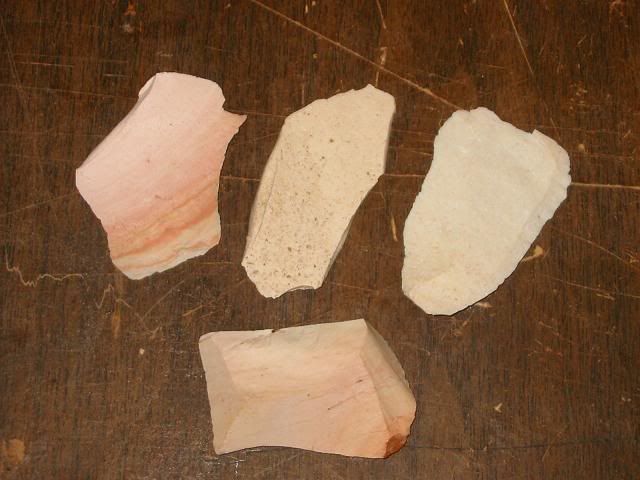I bought this stone (in a honing paddle that looks late 19th century to me) on the Bay, assuming coti from the looks. I cleaned it up and lapped it and there were some strange things that made me doubt it's coti-ness.
First the pattern. I've never seen a pattern like that on a coti. It looks like some kind of sandstone to me.
The slurry is the bleach white I've seen on both Coticules and Novaculites, but unlike either of them (that I've experienced) when it's heavy (When I was lapping for instance) it is a BOLD gold color. It actually dyed several paper towels bright yellow on me. I also took it to the belt sander to fix some serious dishing it had, and it threw off a ton of very fine yellow powder. It seems a good bit softer than any coticule I've used before as well.
As for the edge? As good as anything I've shaved with. Right up there with Thuringians. And smooth as... something really, really smooth. I treated it like a coticule to touch up a razor finished on Thuringian by using a very very wispy slurry for maybe 40 passes, then another 50 passes or so on straight water, and it certainly didn't degrade the edge. If anything it improved it.
So, any thoughts? Is this some really really old layer of coticule that's ultra-rare or some other stone? I've never heard of sandstone hones that were this fine, but maybe? I have an inkling this is maybe a Ratisbon Hone. (Hone mentioned in some century old texts that sounds by description to be a coticule, except that it is apparently from the Ratisbon region of Germany).
http://i268.photobucket.com/albums/jj29/Lithan1/a1.jpg
http://i268.photobucket.com/albums/jj29/Lithan1/a2.jpg
http://i268.photobucket.com/albums/jj29/Lithan1/a3.jpg
http://i268.photobucket.com/albums/jj29/Lithan1/a4.jpg
http://i268.photobucket.com/albums/jj29/Lithan1/a5.jpg
http://i268.photobucket.com/albums/jj29/Lithan1/a6.jpg
First the pattern. I've never seen a pattern like that on a coti. It looks like some kind of sandstone to me.
The slurry is the bleach white I've seen on both Coticules and Novaculites, but unlike either of them (that I've experienced) when it's heavy (When I was lapping for instance) it is a BOLD gold color. It actually dyed several paper towels bright yellow on me. I also took it to the belt sander to fix some serious dishing it had, and it threw off a ton of very fine yellow powder. It seems a good bit softer than any coticule I've used before as well.
As for the edge? As good as anything I've shaved with. Right up there with Thuringians. And smooth as... something really, really smooth. I treated it like a coticule to touch up a razor finished on Thuringian by using a very very wispy slurry for maybe 40 passes, then another 50 passes or so on straight water, and it certainly didn't degrade the edge. If anything it improved it.
So, any thoughts? Is this some really really old layer of coticule that's ultra-rare or some other stone? I've never heard of sandstone hones that were this fine, but maybe? I have an inkling this is maybe a Ratisbon Hone. (Hone mentioned in some century old texts that sounds by description to be a coticule, except that it is apparently from the Ratisbon region of Germany).
http://i268.photobucket.com/albums/jj29/Lithan1/a1.jpg
http://i268.photobucket.com/albums/jj29/Lithan1/a2.jpg
http://i268.photobucket.com/albums/jj29/Lithan1/a3.jpg
http://i268.photobucket.com/albums/jj29/Lithan1/a4.jpg
http://i268.photobucket.com/albums/jj29/Lithan1/a5.jpg
http://i268.photobucket.com/albums/jj29/Lithan1/a6.jpg


